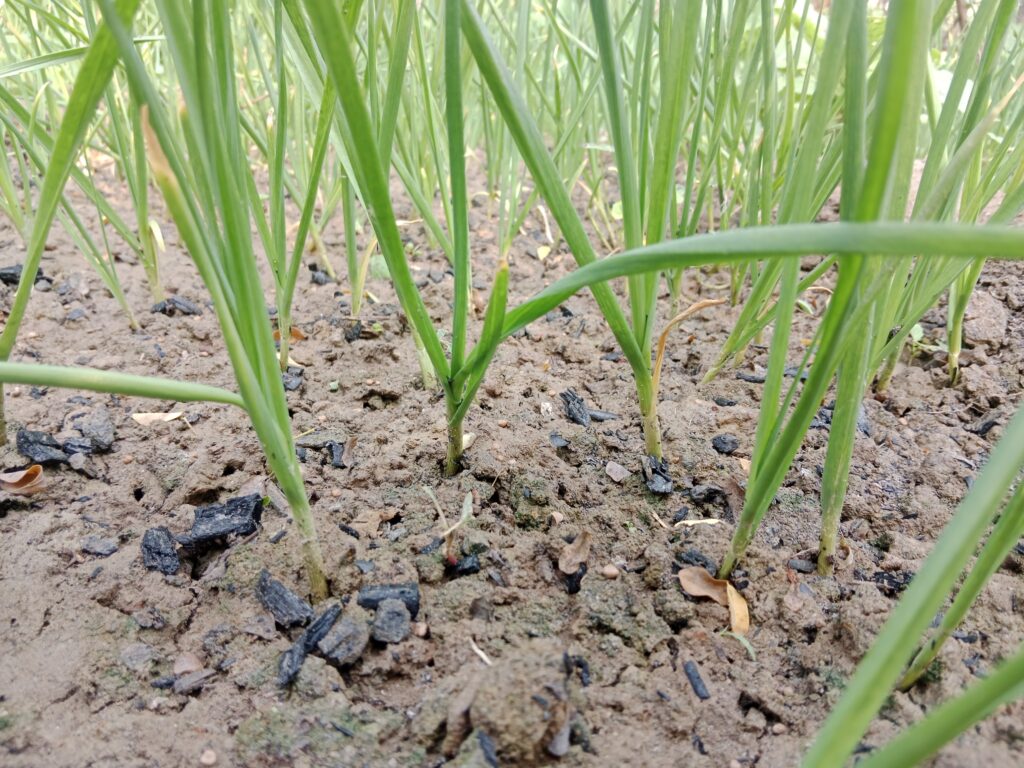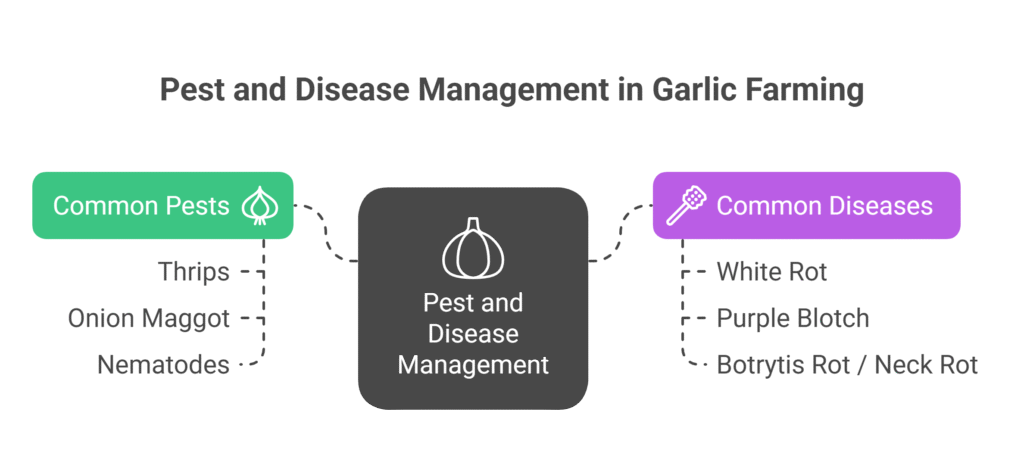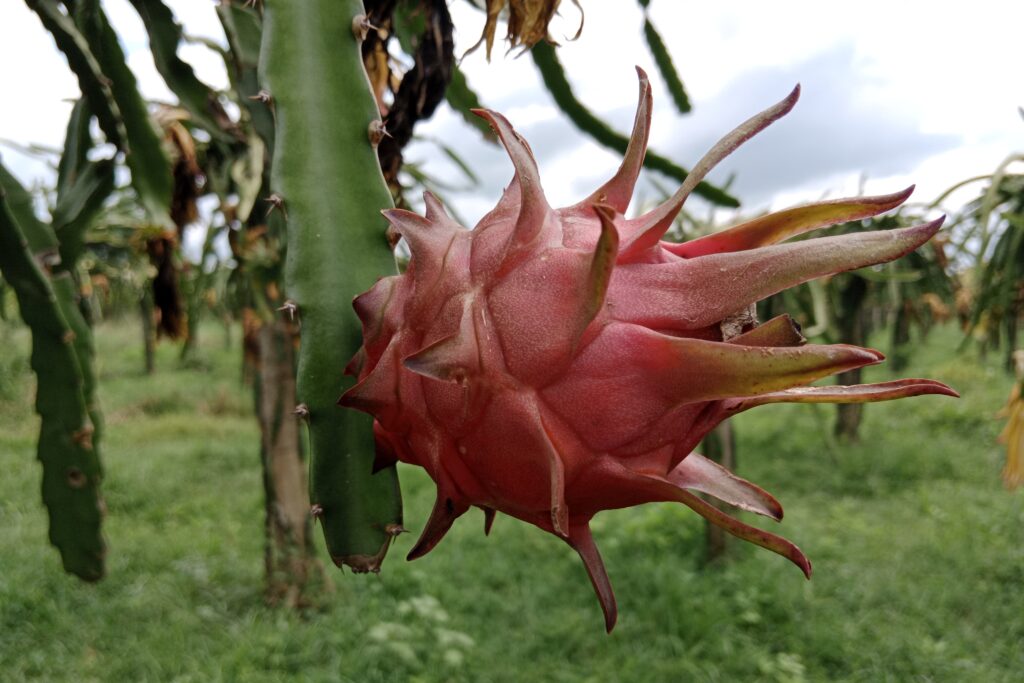Garlic Farming
Garlic (Allium sativum) is a highly valued bulb crop cultivated globally for its culinary flavor and medicinal benefits. Among spice crops, it stands out not only for its versatility but also for its economic viability. Garlic farming profit per acre can be exceptionally rewarding when proper cultivation practices are followed, offering substantial returns to both smallholder and commercial growers.

In a well-managed production cycle, farmers can earn a gross and pre-tax net profit of up to NRs. 190,000 per acre. This remarkable profitability is further highlighted by a Return on Investment (ROI) of 380%, meaning that for every rupee spent, growers can expect to earn nearly four times the investment. With such high returns and growing market demand, garlic continues to be a profitable and attractive crop for agricultural entrepreneurs.
Land Preparation
Land preparation begins with 1-2 deep plowings (20-25 cm deep) using a moldboard plow to loosen the soil, improve aeration, and facilitate root and bulb development. Following this, 3-4 harrowings are conducted to break down soil clods and create a fine, friable tilth, with precise leveling being crucial for ensuring uniform water distribution and preventing waterlogging.
Finally, raised beds (15-20 cm high and 1-1.2 m wide) are formed to provide optimal drainage, particularly in heavy soil or high rainfall areas, incorporating well-decomposed organic matter during this final stage; furrows between the beds aid in irrigation.
Soil Type
Garlic grows best in fertile, sandy loam or loam soils that drain well, as bulb rot, a typical problem in waterlogged conditions, can be avoided with sufficient drainage. Sand and organic matter must be added to heavy clay soils to improve permeability. Because excessive acidity (below 5.5) and alkalinity (above 8.0) can hinder development and nutrient absorption, the ideal soil pH range for garlic cultivation is slightly acidic to neutral (pH 6.0–7.5). An excessively acidic soil would require the application of lime.
Climatic Requirements
| Factor | Requirement/Optimal Condition |
| Temperature | |
| · Vegetative Growth | 13°C to 24°C (55°F to 75°F) |
| · Bulb Initiation & Development | 15°C to 25°C (59°F to 77°F). High temperatures (>30°C / 86°F) reduce yield/quality. |
| · Vernalization | 4-8 weeks at 0°C to 10°C (32°F to 50°F) post-planting (naturally met in temperate winters). |
| Photoperiod | Long-day plant; bulbing triggered at day lengths of 13-14 hours or longer. |
| Rainfall/Water | Consistent moisture is required (especially during bulb formation). 25-40 inches of well-distributed rainfall or irrigation. High humidity/excessive rainfall increases disease risk. |
Major Cultivars
When selecting garlic varieties, consider key factors such as compatibility with the local climate, especially the chilling requirement, as well as market preferences related to flavor, clove size, and storage quality. Additionally, prioritize varieties with strong disease resistance and those best suited for the intended use, whether for fresh consumption, processing, or long-term storage.
| Characteristic | Softneck (Subsp. sativum) | Hardneck (Subsp. ophioscorodon) |
| Stalk/Central Feature | No central stalk; flexible neck | Central woody stalk (scape) |
| Commercial Use | Most common commercially | Less common |
| Storage | Stores very well | Shorter storage life (4-6 months) |
| Flavor Profile | Generally milder | More complex and stronger |
| Cloves | Many small cloves | Fewer, larger cloves |
| Neck Utility | Suitable for braiding | N/A |
| Peeling Ease | Standard | Easier to peel |
| Climate Adaptation | Better adapted to milder winters | Requires cold winters |
| Unique Features | – | Produces edible scapes |
| Examples | California Early, California Late, Silverskin, Artichoke | Rocambole, Porcelain, Purple Stripe |
Seed Rate per Acre
| Category | Specification | Purpose/Notes |
| Seed Selection | Large, healthy cloves | Leads to the development of larger bulbs |
| Seed Rate | 225–250 kg per acre | Recommended quantity for planting |
| Chemical Treatment | Thiram: 2 g per kg of seed | Protects against damping-off and smut diseases |
| Bio-agent Treatment | Trichoderma viride: 2 g per kg of seed | Applied after chemical treatment. Reduces early seedling diseases and soil-borne inoculum |
Planting
a) Planting Season
Garlic is generally planted in the fall, typically during October to November, to ensure proper bulb development and optimal yield.
b) Spacing
Garlic should be sown with 15 cm between rows and 10 cm between cloves within each row. Each clove should be placed with the pointed end facing upward at a depth of 2.5 to 5 cm.
c) Planting Method
Hand planting is typically practiced in small-scale garlic cultivation, while commercial operations often use mechanical planters—such as modified bulb planters or vacuum seeders—for greater speed and planting uniformity.
d) Number of Plants per Acre
Based on the above spacing, approximately 269,800 garlic plants can be accommodated per acre.
Irrigation
Irrigation is crucial during key stages of garlic growth, including germination and establishment, active leaf development, and particularly during bulb initiation and enlargement. Consistent soil moisture is necessary—though not waterlogged—and irrigation should be applied when the top 1–2 inches of soil feel dry.
The frequency varies with soil type and weather, with weekly irrigation often needed during dry periods, especially during bulbing. Drip irrigation is highly recommended due to its efficiency, reduced leaf wetness (which lowers disease risk), and precise delivery to the root zone. Furrow irrigation is also commonly used, while overhead sprinklers should be avoided. To promote proper bulb maturation and reduce the risk of rot, irrigation should be stopped 2–3 weeks before the anticipated harvest.
Fertilizer and Manure
To ensure accurate nutrient management, fertilizers should be administered by the findings of a soil test; nevertheless, if a test is not conducted, the general fertilizer recommendations listed in the table can be used as a reference to efficiently meet the crop’s nutritional needs.
| Input Type | Material | Rate/Timing |
| Organic Matter | Well-decomposed FYM or Compost | 10–15 tons/acre during land preparation |
| Biofertilizer | Azospirillum | 800 g/acre at last plough |
| Phosphorus Solubilizing Bacteria | 800 g/acre at last plough | |
| Nitrogen (N) | Urea or equivalent | 100–150 kg N/acre (1/3 at planting, 1/3 at 30 DAP, 1/3 at 45–60 DAP) |
| Phosphorus (P₂O₅) | SSP/DAP or equivalent | 50–80 kg P₂O₅/acre Full dose as basal during planting |
| Potassium (K₂O) | MOP or equivalent | 80–120 kg K₂O/acre (Split: 1/2 planting, 1/2 at 30 DAP) |
| Micronutrient | Magnesium Sulphate | 20 kg/acre 45 days after planting |
Weed Control
Weed control is critical in garlic, especially during the first 6-8 weeks of high competition. Effective methods include mulching (straw, grass, plastic), shallow cultivation between rows, and hand weeding within rows. Due to slow seedling growth, chemical herbicides are preferred initially: apply Pendimethalin (1 L/200 L water/acre) within 72 hours of sowing as a pre-emergent, followed by Oxyfluorfen (425 ml/200 L water/acre) 7 days after planting as a post-emergent. Supplement with two hand weedings at one-month intervals starting one-month post-sowing.
Flowering and Fruit Management
In garlic cultivation, hardneck varieties produce a central flower stalk known as a scape, which should be removed by snapping or cutting as it begins to curl—typically 4–6 weeks before harvest—to redirect the plant’s energy into bulb development, boosting yield by 20–30%. Softneck varieties usually do not produce scapes under normal conditions, so removal is unnecessary. Although garlic can rarely produce true seeds, it is almost exclusively propagated vegetatively through cloves.
Pest and Disease Management
Common Pests
a) Thrips
Thrips, commonly seen in dry weather, can cause up to 50% yield loss if not properly managed. They feed on plant sap, leading to leaf curling and an upward, cup-shaped appearance. To monitor their severity, install 6–8 blue sticky traps per acre. If infestation is observed, apply a spray of Fipronil at 30 ml per 15 liters of water or Profenophos at 10 ml, or a combination of Carbosulfan 10 ml and Mancozeb 25 gm per 10 liters of water at intervals of 8–10 days.
b) Onion Maggot
Onion maggot infestation, commonly occurring in January–February, involves larvae tunneling into bulbs and feeding on roots, which results in browning of leaves and a watery base of the plant. Upon detection, apply Carbaryl at 4 kg per acre to the soil, followed by light irrigation for effective control.
c) Nematodes
Nematodes cause stubby roots and distorted stems and bulbs, resulting in stunted plant growth. Management involves long crop rotations of over four years, soil solarization, the use of resistant cultivars, and the application of nematicides in severe cases. Specifically, applying Carbofuran 3G at 1 kg a.i. per hectare, 30 days after planting, can effectively control nematode infestation.

Common Diseases
a). White Rot
White rot (Sclerotium cepivorum) is a highly destructive fungal disease marked by white mold and black sclerotia on roots and bulbs. Effective management includes practicing very long crop rotations of over 10 years, avoiding the use and movement of infected seed or soil, and applying fungicides, though their effectiveness is limited.
b). Purple Blotch
Purple blotch and Stemphylium blight can cause up to 70% yield loss under severe infestation, characterized by deep purple lesions on leaves and yellow streaks that turn brown and spread along the leaf blade. To control the disease, spray Propineb 70% WP at 350 grams per acre in 150 liters of water, twice at 10-day intervals.
c). Botrytis Rot / Neck Rot
Botrytis rot or neck rot (Botrytis spp.) is a fungal disease that causes gray mold and storage rot in garlic. It can be managed by avoiding mechanical injuries, ensuring proper curing and storage conditions, and applying fungicides such as azoxystrobin at 0.5 ml per liter of water.
Harvesting
Harvesting garlic at the right time is critical—ideally when the lower 3–4 leaves have turned yellow or brown and the upper 5–6 leaves remain partially green, typically 6–9 months after planting, depending on the cultivar and season. Delayed harvesting can cause bulb wrappers to split, reducing storage quality. Use a digging fork or lifter inserted away from the bulbs to carefully loosen and lift them without causing damage; avoid pulling by the tops, as they break easily. Handle the bulbs gently to prevent bruising, which can lead to storage rot.
Yield
Fresh garlic bulb yields typically range from 3 to 6 tons per acre under good commercial cultivation practices.
Post-Harvest
Curing garlic bulbs requires three to four weeks in a warm, dry, well-ventilated, shady place until the outer scales turn papery and the necks tighten. After curing, bulbs are placed in a cold, dry, and well-ventilated area (between 0 and 2°C), with the roots and tips clipped for storage. Compared to hardnecks, softneck variants usually last longer in storage. The bulbs are classified according to size and sorted after adequate drying.
Cost of Investment per Acre for Garlic Farming
| S.N. | Category | Cost (NRs) |
| 1 | Land Preparation (plowing) | 15,000 |
| 2 | Seed cost | 5,000 |
| 3 | Planting | 2,000 |
| 4 | Fertilizers and Manure | 10,000 |
| 5 | Irrigation | 5,000 |
| 6 | Weed Control | 4,000 |
| 7 | Pest & Disease Control | 3,000 |
| 8 | Harvesting | 3,000 |
| 9 | Miscellaneous Costs | 3,000 |
| TOTAL COST | 50,000 |
Income from Per Acre Garlic Farming
| Particulars | Yield (kg/acre) | Price (NRs/kg) | Income (NRs) |
| Garlic Yield | 3,000 | 80 | 240,000 |
| TOTAL INCOME | 240,000 |
Analysis of Garlic Farming Profit Per Acre
| Metric | Calculation | Amount (NRs) |
| Gross Profit | Income – Total Cost | 190,000 |
| Net Profit | (Pre-tax) | 190,000 |
| Return on Investment (ROI) | (Profit / Cost) × 100 | 380% |
The garlic farming operation yields a gross and pre-tax net profit of NRs. 190,000. With a return on investment (ROI) of 380%, calculated by dividing the profit by the total cost and multiplying by 100, the venture demonstrates high profitability.
Garlic Farming Crop Calendar per Acre Basis
(Timings are approximate; adjust for local climate & variety)
| Month | Growth Stage | Key Operations & Management Practices | Critical Notes |
| Aug-Sep | Pre-Planting | · Soil Testing (adjust lime/FYM based on results) | Ideal pH: 6.0-7.5. Lime if <5.5. |
| · Land Preparation: 1-2 deep plowings + 3-4 harrowings + leveling | Ensure fine tilth. 20-25 cm depth. | ||
| · Bed Formation: Raised beds (1-1.2m width, 15-20cm height) + furrows | Incorporate 10-15 tons FYM/compost + biofertilizers (Azospirillum, PSB). | ||
| Oct-Nov | Planting | · Seed Treatment: Treat cloves with Thiram (2g/kg) + Trichoderma (2g/kg) | Use large, disease-free cloves. |
| (Day 0) | (Establishment) | · Planting: 10 cm (row-to-row) × 15 cm (plant-to-plant), 2.5-5 cm depth | Pointed end up. 225-250 kg seed/acre (~2.7 lakh plants). |
| · Basal Fertilizers: Apply 100% P₂O₅ + 50% K₂O + ⅓ N | Use DAP/SSP for P, MOP for K. | ||
| · Pre-Emergent Herbicide: Pendimethalin (1L/200L water/acre) within 72 hrs | Controls early weeds. | ||
| Dec-Jan | Vegetative Growth | · 1st Top-Dressing: ⅓ N at 30 DAP + 50% K₂O | Urea for N. Irrigate after application. |
| · Weed Control: 1st hand weeding (30 DAP) + Post-emergent Oxyfluorfen (if needed) | Oxyfluorfen: 425ml/200L water/acre at 7 DAP. | ||
| · Pest Monitoring: Install blue sticky traps for thrips | Thrips thrive in dry weather. | ||
| Feb-Mar | Bulb Initiation | · 2nd Top-Dressing: ⅓ N + Magnesium Sulphate (20kg/acre) at 45-60 DAP | Critical for bulb enlargement. |
| · 2nd Hand Weeding: 60 DAP | Remove weeds competing for nutrients. | ||
| · Irrigation: Peak water demand (keep soil moist, not waterlogged) | Use drip/furrow; avoid sprinklers. | ||
| · Pest Control: Spray for thrips/maggots if detected (e.g., Fipronil for thrips, Carbaryl for maggots) | Maggots active Jan-Feb; thrips in dry spells. | ||
| Apr | Bulb Development | · Scape Removal (Hardneck Only): Cut curly scapes 4-6 weeks pre-harvest | Boosts bulb size by 20-30%. Softnecks don’t need this. |
| · Disease Control: Monitor for Purple Blotch/White Rot; spray Propineb if needed | High humidity increases disease risk. | ||
| · Reduce Irrigation gradually | Prepare for harvest. | ||
| May-Jun | Maturity & Harvest | · Stop Irrigation: 2-3 weeks pre-harvest | Prevents rot and improves storage. |
| · Harvest: When 3-4 lower leaves brown, upper leaves partially green (6-9 months after planting) | Lift bulbs gently with fork; avoid bruising. Delay causes split wrappers. | ||
| Jun-Jul | Post-Harvest | · Curing: 3-4 weeks in shade (warm, dry, ventilated) | Ready when necks are tight, skins papery. |
| · Trimming & Sorting: Clip roots/tops + grade by size | Softnecks store longer than hardnecks. | ||
| · Storage: Cold (0-2°C), dry, ventilated area | Check periodically for rot. | ||
| Year-Round | Off-Season | · Crop Rotation: Plan 4-10 year breaks for pest/disease control (esp. white rot/nematodes) | Avoid allium crops (onion, leek). |
| · Soil Solarization: In summer for disease-prone fields | Reduces soil-borne pathogens. |
Source
Tamil Nadu Agricultural University (TNAU) Agritech Portal
Food and Agriculture Organization (FAO)
Indian Council of Agricultural Research (ICAR)
Nepal Agricultural Research Council (NARC)



